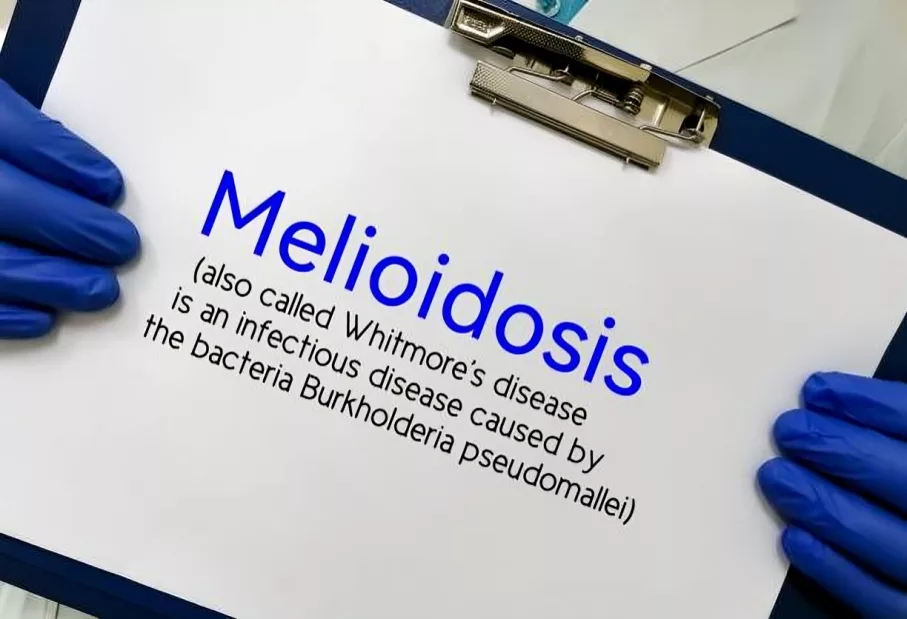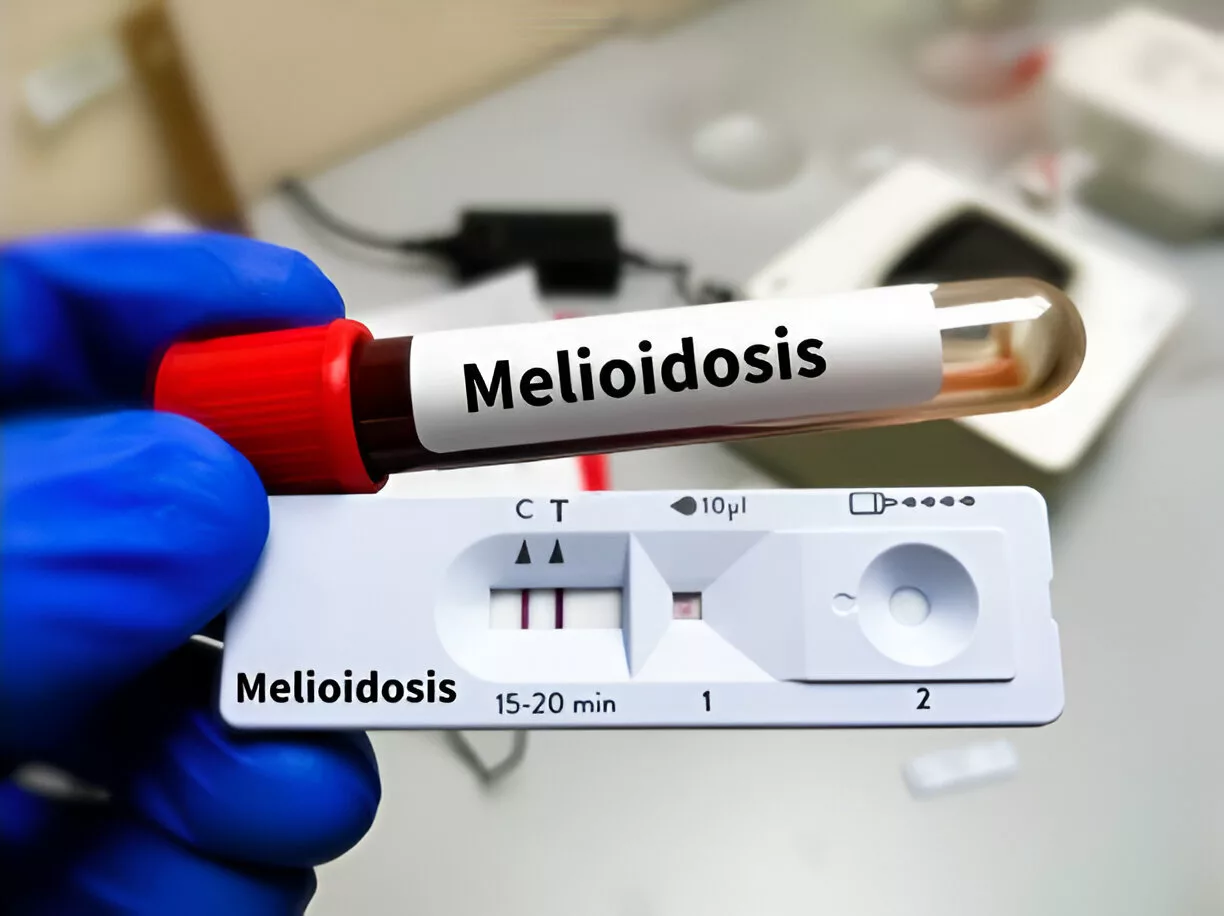Melioidosis, or Whitmore’s disease, is a potentially life-threatening infection caused by the gram-negative bacterium Burkholderia pseudomallei, which is found in soil and water in tropical regions. The disease can range from asymptomatic or mild illness to severe sepsis or pneumonia. It often starts without symptoms but can worsen into a severe illness that resembles tuberculosis. Without proper treatment, it can become life-threatening.
How common is Melioidosis?
Each year, 165,000 people around the world get melioidosis. 138,000 cases happen in East and South Asia and the Pacific. Since 2010, only 1,300 cases have been recorded, which means this infection is extremely underreported.
In the United States, two cases of this infection were found in 1950 and 1971. Four more cases happened between 2010 and 2020. These people had never traveled abroad. Experts think it may have come from imported plants or exotic pets.
More recently, a melioidosis outbreak happened in the United States in 2021. It was linked to contaminated aromatherapy spray from India. Some people have also gotten infected by tropical fish in home aquariums. Parts of the Southern States are sometimes considered endemic for melioidosis ever since the bacteria was found in the environment in Mississippi.1 CDC. (2024, June 12). Melioidosis and Cases Around the World. Melioidosis. https://www.cdc.gov/melioidosis/risk-factors/index.html
What causes Melioidosis?
Melioidosis is caused by Burkholderia pseudomallei, which is a Gram-negative rod-shaped bacterium. This bacterium can survive in extreme environments, such as muddy water, rice fields, and deep soil layers. It can even persist for years in contaminated areas unless eradicated.
Transmission of Melioidosis
Burkholderia pseudomallei can spread through a variety of modes and transmit the disease, such as:
- The bacteria enter your body through cuts and disrupted mucus membranes.
- You might breathe Burkholderia pseudomallei when dust or water droplets become airborne.
- Drinking untreated water or eating unwashed fruits and vegetables grown in infected soil can make you contract melioidosis.
- Although uncommon, you can get melioidosis through direct contact with body fluids from an infected person. This has happened in cases where caregivers or family members were exposed, as well as during childbirth.
- In rare cases, you could get melioidosis through an organ transplant, blood transfusion, or contaminated medical equipment.
Risk Factors for Melioidosis
Many risk factors put you at risk for this infection. The most common factors are diabetes mellitus and living in an endemic area.
Diabetes Mellitus:
Diabetes is the biggest risk factor for melioidosis. More than half of the people who get the disease have diabetes, and diabetics are 12 times more likely to get infected. High blood sugar weakens the immune system because it reduces the ability of your white blood cells to kill bacteria. It also affects T-helper cells, which are important for fighting infections. On top of that, the immune system in diabetics tends to release too many inflammatory markers, which increases the risk of severe disease and septic shock.2Currie BJ Melioidosis: evolving concepts in epidemiology, pathogenesis, and treatment. Semin. Respir. Crit. Care Med 36, 111–125 (2015).
Geography:
Burkholderia pseudomallei thrives in warm, humid conditions, such as the tropics, where the disease is prevalent. Many people in regions where melioidosis is common develop antibodies against Burkholderia pseudomallei without ever showing symptoms. In Thailand, more than half the population has antibodies, while in Australia, about 5% do.
In addition, cases rise after heavy rain and floods. Rainwater disturbs the soil and brings bacteria to the surface. It then becomes easier to inhale or come into contact with the bacteria.
Other Medical Conditions:
People with chronic kidney disease have a weaker immune system. Those with chronic lung diseases or bronchiectasis are also at higher risk. This is because lung damage makes it easier for the bacteria to infect the respiratory system, complicating melioidosis and causing pneumonia and lung abscesses.
Individuals who are living with disorders of the immune system e.g., HIV, are at risk for this infection. People taking long-term steroids, chemotherapy, or other drugs that suppress the body’s immunity are also more likely to get melioidosis.
Occupational Exposure:
Farmers — especially rice farmers — are at high risk for melioidosis because they frequently come into contact with contaminated soil and water. Other outdoor professionals like fishermen, scientists, gardeners, and construction workers are also at risk.3 Melioidosis. (2023). Australian Journal of General Practice. https://www1.racgp.org.au/ajgp/2019/may/melioidosis-an-updated-review
Different Types of Melioidosis
This infection is classified into several types depending on when you contracted the infection and developed its symptoms, such as:
Latent Melioidosis:
Latent melioidosis occurs when a person is infected with Burkholderia pseudomallei but does not develop symptoms for months or even years. There have been cases where this infection appeared decades after exposure, sometimes misdiagnosed as tuberculosis or cancer due to its delayed onset.
Localized Melioidosis:
Localized melioidosis only affects a specific area of your body, e.g., the skin or soft tissues. The affected area may be swollen, red, and painful. You may also have a fever or feel generally unwell. Sometimes, the bacteria invade deeper into the tissues and cause serious complications like cellulitis and necrotizing fasciitis. In Thailand, children often develop pus-filled swelling in the salivary glands.4 Gupta, N., Malla, S., Boodman, C., Kumar, T. P., Varma, M., & Mukhopadhyay, C. (2024). Abscesses due to Melioidosis: a case-based review. Current Research in Microbial Sciences, 8, 100321–100321. https://doi.org/10.1016/j.crmicr.2024.100321
Subacute Melioidosis:
In the subacute type, the infection takes weeks or months to develop. The incubation period — the time between infection and symptoms — can be much longer than in acute cases. Because of this, people may not immediately realize they are infected, and symptoms can be mistaken for other illnesses like tuberculosis or prolonged viral infections.
Chronic Melioidosis:
In chronic melioidosis, your symptoms last more than two months. You may have a fever, weight loss, and a cough that brings up blood. Chronic melioidosis makes up around 10% of the total cases of melioidosis. It can develop in two ways — de novo, meaning it starts as a chronic infection from the beginning or as a progression from the subacute form that was not wholly treated. This type of melioidosis is often misdiagnosed as tuberculosis, chronic pneumonia, or other long-term infections because of its slow progression and non-specific symptoms.
Disseminated Melioidosis:
Disseminated melioidosis is a severe form of the disease where Burkholderia pseudomallei spreads through the bloodstream to infect multiple organ systems in the body. This can happen when the infection is not treated early or when the immune system is too weak to fight it off. This causes a wide range of symptoms depending on where the abscesses are formed. Without treatment, disseminated melioidosis causes organ failure, septic shock, and death. 5W. Joost Wiersinga, Virk, H. S., Torres, A. G., Currie, B. J., Peacock, S. J., David, & Direk Limmathurotsakul. (2018). Melioidosis. Nature Reviews Disease Primers, 4(1). https://doi.org/10.1038/nrdp.2017.107

Signs & Symptoms of Melioidosis
The symptoms can appear suddenly or develop gradually over days to weeks, usually within 1 to 21 days after exposure. Severe symptoms often stem from lung infections, such as pneumonia. The disease can last for months, and in some cases, symptoms reappear years later. Signs and symptoms of melioidosis include:
Acute Pulmonary Infection:
This is the most common presentation of melioidosis. It can be mild or very severe, and symptoms can start suddenly or develop slowly. You may have:
- Headaches
- Loss of appetite
- Chest pain
- Muscle aches
- Fever higher than 39°C
- Coughing, including coughing up blood
- Fast breathing
- Crackling sounds in the lungs
Acute Septicemic Infection:
Acute septicemic infection starts suddenly and causes severe infection in many organs. Widespread symptoms may occur, such as:
- High fever
- Confused
- Fast, difficult breathing
- Severe headaches
- Sore throat
- Low blood pressure
- Abdominal pain
- Diarrhea
- Pus-filled skin sores
- Flushed, bluish skin
- Tender muscles
- Arthritis
- Meningitis6Nguyen, H. N., Smith, M. E., & Hayoun, M. A. (2023, August 14). Glanders and Melioidosis. Nih.gov; StatPearls Publishing. https://www.ncbi.nlm.nih.gov/sites/books/NBK448110/
Complications of Melioidosis
Without treatment and in complicated cases, melioidosis can have a mortality of 90%. Melioidosis can cause serious complications by spreading to different parts of your body. Some of these can be life-threatening if not treated quickly, such as:
- Gastrosplenic fistula
- Guillain-Barré syndrome
- Constrictive pericarditis
- Portal vein thrombosis
- Acute renal failure
- Mycotic aneurysm
- Acute parkinsonism
- Pacemaker infection
- Endophthalmitis7Jedsada Kaewrakmuk, Sarunyou Chusri, Thanaporn Hortiwakul, Soontara Kawila, Wichien Patungkaro, Benjamas Jariyapradub, Pattamas Limvorapan, Bongkoch Chiewchanyont, Hathairat Thananchai, Kwanjit Duangsonk, & Apichai Tuanyok. (2023). Under-Reporting Cases and Deaths from Melioidosis: A Retrospective Finding in Songkhla and Phatthalung Province of Southern Thailand, 2014–2020. Tropical Medicine and Infectious Disease, 8(5), 286–286. https://doi.org/10.3390/tropicalmed8050286
How is a Melioidosis diagnosis established?
Melioidosis is difficult to diagnose because it is either asymptomatic or has a similar clinical picture to other diseases. Suspicion arises if you have been to an endemic area and is confirmed on lab tests.
History & Exam:
Doctors diagnose melioidosis by first asking about your travel history, job, and health conditions. They check if you have been to places like Southeast Asia or Northern Australia or if you work with soil and water. They also ask about medical conditions like diabetes, kidney disease, or a weak immune system, which can increase your risk.
Next, they examine your body for signs of infection. They check your temperature, heart rate, and blood pressure to see if you have a serious infection. They also look for skin sores, abscesses, or lung problems like pneumonia. If you have joint pain or confusion, they check for joint infections or brain involvement.
Lab Investigations:
Since melioidosis can look like other illnesses, doctors use lab tests to determine whether you have the disease or not. These lab investigations include:
- Routine blood tests to get an idea of your overall health, such as
- Complete blood count
- Liver function tests
- Renal function tests
- Serum electrolytes
- Coagulation profile
- Viral markers
- Samples to check for the growth of Burkholderia pseudomallei are the gold standard for diagnosing melioidosis. A number of these are taken:
- Blood culture
- Sputum culture
- Throat swab
- Stool culture
- Urine culture
- Wound culture
- ELISA can detect antibodies against Burkholderia pseudomallei
- Polymerase chain reaction test detects Burkholderia pseudomallei DNA in your body
- Indirect hemagglutinin assay checks the response of your antibodies to a possible infection

Imaging:
Sometimes, doctors use radiologic scans to check for abscesses in different parts of your body. These scans help them find out which organs have been affected and start the appropriate treatment. Examples of imaging for melioidosis include:
- Your doctor will use a chest X-ray to check for lung infections. It can show cavities, nodules, or fluid buildup around your lungs, which are common in melioidosis.
- A CT scan helps detect abscesses in your internal organs that might not appear on a regular X-ray.
- Ultrasound scans are helpful for spotting abdominal abscesses in melioidosis, especially in the liver and spleen. This imaging method is often used when CT scans are not available.
- If melioidosis affects your brain or spinal cord, an MRI can provide high-resolution images to identify infections in these complex areas.
Is there any treatment for Melioidosis?
Melioidosis is treated by removing Burkholderia pseudomallei from your body, which helps you fight the effects of infection.
Antibiotics:
Antibiotics are the primary treatment for melioidosis. The infection requires a two-phase therapy — an initial intensive phase with intravenous or IV antibiotics, which is then followed by a more extended regimen of oral antibiotics to prevent relapse.
- Initial treatment begins with IV antibiotics such as ceftazidime or meropenem. This usually continues for at least 14 days. These drugs help control the infection quickly and prevent it from spreading to vital organs. In case of complications, IV antibiotics may be given for a longer duration.
- Oral antibiotics constitute the eradication phase of melioidosis treatment. After completing IV therapy, you continue oral co-trimoxazole or co-amoxiclav for 3 to 6 months. This long-term treatment helps eliminate any remaining bacteria. It also reduces melioidosis relapse, which is common if the infection is not fully cleared.
- Some strains of Burkholderia pseudomallei are resistant to standard antibiotics. Studies show that about 12.8% of cases are resistant to ceftazidime, and 9.8% are resistant to co-trimoxazole. So, two or more antibiotics are sometimes used. Combining finafloxacin with amikacin or meropenem is used to get rid of bacteria more effectively in antibiotic-resistant cases.8.Barnes, K. B., Richards, M. I., Burgess, G., Armstrong, S. J., Bentley, C., Maishman, T. C., Laws, T. R., Nelson, M., & Harding, S. V. (2022). Investigation of a combination therapy approach for the treatment of melioidosis. Frontiers in Microbiology, 13. https://doi.org/10.3389/fmicb.2022.934312
Supportive Care:
Severe melioidosis can affect multiple organs, so treatment focuses on supporting your body while it fights the infection and recovers. Measures for supportive care include:
- Fever, muscle pain, and joint discomfort are common symptoms. Pain relievers and antipyretics help keep these symptoms under control and improve comfort. Ibuprofen and acetaminophen are commonly used.
- You may experience dehydration due to fever and excessive sweating. IV fluids help restore your hydration and maintain blood pressure.
- If the infection spreads to your lungs and causes pneumonia, oxygen therapy, and nebulization may be needed to support your breathing.
- Melioidosis is more severe in people with diabetes. High blood sugar levels can worsen the infection and slow recovery. Monitoring and managing glucose levels can prevent complications.
Hospitalization:
Most cases of symptomatic melioidosis require hospitalization. Hospital care ensures close monitoring and rapid treatment for a variety of reasons:
- Patients with bloodstream and pulmonary infections need hospital care to receive IV antibiotics and supportive treatment.
- If the infection leads to sepsis, organ failure, and respiratory distress, you may need intensive care. If the condition is highly critical, you may require mechanical ventilation, dialysis, or ionotropic support.
Once stable, patients can switch to oral antibiotics and continue their treatment at home. Regular follow-ups are necessary to monitor recovery and prevent relapse.
What to do for Melioidosis Prevention?
Melioidosis spreads quickly and can be life-threatening. With no vaccine and the risk of antibiotic resistance and reinfection, prevention is the best management for melioidosis. This can be done by taking simple steps, such as:
- If you work outdoors and frequently come into contact with soil and water, wear gloves and avoid walking barefoot.
- Drink clean and boiled or treated water, which is free of all kinds of microorganisms.
- If you have diabetes or a weakened immune system, take care of your health. In case you notice a continuous fever, pneumonia-like symptoms, or unexplained signs of infection, seek medical attention early.
Conclusion
Melioidosis is a dangerous infection caused by the bacteria Burkholderia pseudomallei. It often starts without symptoms, but it can cause fever, cough, skin sores, and serious illness. Melioidosis is treated with antibiotics and supportive care and often requires a hospital stay. Since there is no vaccine, early treatment and prevention are the best ways to stay protected.
Refrences
- 1CDC. (2024, June 12). Melioidosis and Cases Around the World. Melioidosis. https://www.cdc.gov/melioidosis/risk-factors/index.html
- 2Currie BJ Melioidosis: evolving concepts in epidemiology, pathogenesis, and treatment. Semin. Respir. Crit. Care Med 36, 111–125 (2015).
- 3Melioidosis. (2023). Australian Journal of General Practice. https://www1.racgp.org.au/ajgp/2019/may/melioidosis-an-updated-review
- 4Gupta, N., Malla, S., Boodman, C., Kumar, T. P., Varma, M., & Mukhopadhyay, C. (2024). Abscesses due to Melioidosis: a case-based review. Current Research in Microbial Sciences, 8, 100321–100321. https://doi.org/10.1016/j.crmicr.2024.100321
- 5W. Joost Wiersinga, Virk, H. S., Torres, A. G., Currie, B. J., Peacock, S. J., David, & Direk Limmathurotsakul. (2018). Melioidosis. Nature Reviews Disease Primers, 4(1). https://doi.org/10.1038/nrdp.2017.107
- 6Nguyen, H. N., Smith, M. E., & Hayoun, M. A. (2023, August 14). Glanders and Melioidosis. Nih.gov; StatPearls Publishing. https://www.ncbi.nlm.nih.gov/sites/books/NBK448110/
- 7Jedsada Kaewrakmuk, Sarunyou Chusri, Thanaporn Hortiwakul, Soontara Kawila, Wichien Patungkaro, Benjamas Jariyapradub, Pattamas Limvorapan, Bongkoch Chiewchanyont, Hathairat Thananchai, Kwanjit Duangsonk, & Apichai Tuanyok. (2023). Under-Reporting Cases and Deaths from Melioidosis: A Retrospective Finding in Songkhla and Phatthalung Province of Southern Thailand, 2014–2020. Tropical Medicine and Infectious Disease, 8(5), 286–286. https://doi.org/10.3390/tropicalmed8050286
- 8.Barnes, K. B., Richards, M. I., Burgess, G., Armstrong, S. J., Bentley, C., Maishman, T. C., Laws, T. R., Nelson, M., & Harding, S. V. (2022). Investigation of a combination therapy approach for the treatment of melioidosis. Frontiers in Microbiology, 13. https://doi.org/10.3389/fmicb.2022.934312





